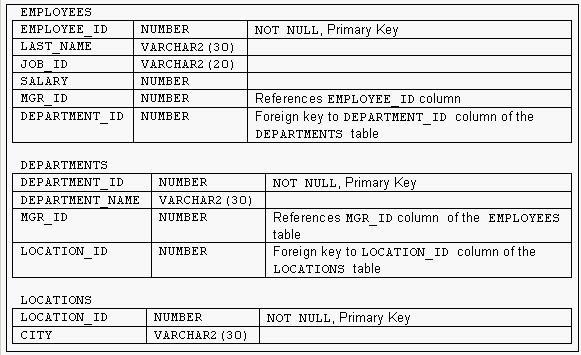出自:Oracle认证
Click the Exhibit button to examine the structure of the EMPLOYEES, DEPARTMENTS, and LOCATIONS tables. Two new departments are added to your company as shown: DEPARTMENT_ID DEPARTMENT_NAME MGR_ID LOCATION_ID 9998 Engineering 123 9999 Administrative Boston You need to list the names of employees, the department IDs, the department names, and the cities where the departments are, even if there are no employees in the departments and even if the departments are not yet assigned to a location. You need to join the EMPLOYEES, DEPARTMENTS, and LOCATIONS tables to retrieve this information. Which statement do you execute to retrieve this information?()
A:SELECT e.last_name, d.department_id, d.department_name, l.city FROM departments d RIGHT OUTER JOIN employees e ON d.department_id = e.department_id RIGHT OUTER JOIN locations l ON d.location_id = l.location_id;
B:SELECT e.last_name, d.department_id, d.department_name, l.city FROM departments d FULL OUTER JOIN employees e ON d.department_id = e.department_id FULL OUTER JOIN locations l ON d.location_id = l.location_id;
C:SELECT e.last_name, d.department_id, d.department_name, l.city FROM departments d LEFT OUTER JOIN employees e ON d.department_id = e.department_id LEFT OUTER JOIN locations l ON d.location_id = l.location_id;
D:SELECT last_name, department_id, department_name, city FROM departments d NATURAL JOIN employees e NATURAL JOIN locations l;
The ORDERS table has these columns: ORDER_ID NUMBER(4) NOT NULL CUSTOMER_ID NUMBER(12) NOT NULL ORDER_TOTAL NUMBER(10,2) The ORDERS table tracks the Order number, the order total, and the customer to whom the Order belongs. Which two statements retrieve orders with an inclusive total that ranges between 100.00 and 2000.00 dollars? ()
A:SELECT customer_id, order_id, order_total FROM orders RANGE ON order _ total (100 AND 2000) INCLUSIVE;
B:SELECT customer_id, order_id, order_total FROM orders HAVING order _ total BETWEEN 100 and 2000;
C:SELECT customer_id, order_id, order_total FROM orders WHERE order _ total BETWEEN 100 and 2000;
D:SELECT customer_id, order_id, order_total FROM orders WHERE order_total>= 100 and <= 2000;
E:SELECT customer_id, order_id, order_total FROM orders WHERE order_total>= 100 and order_total <= 2000;